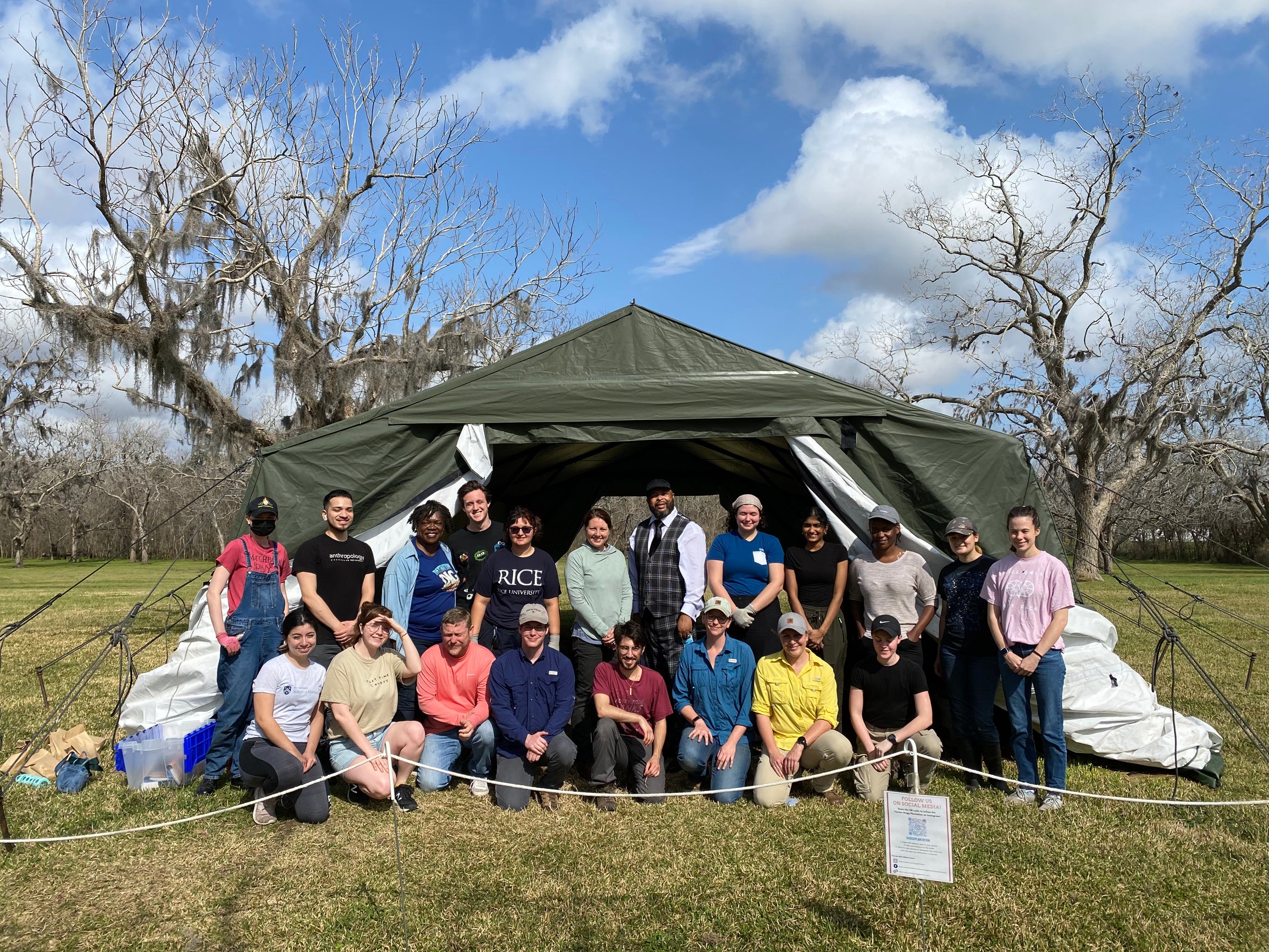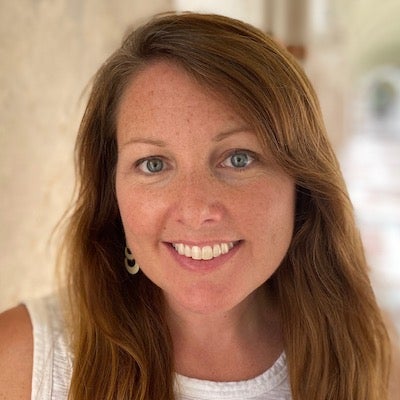The Department of Anthropology at Rice University and the Texas Historical Commission have embarked on a community-based archaeology research project to study the lives of the captive laborers including enslaved people and prisoners from the convict leasing system who worked and lived at Varner-Hogg Plantation in Brazoria County in the 19th and 20th centuries. Through community engagement and archaeological field and lab research, the project aims to examine the historical context and legacies of slavery and how it is presented in cultural heritage and public history. The Rice University archaeology team of faculty and students is led by Molly Morgan, Ph.D. and Jeffrey Fleisher, Ph.D.
What is community-based archaeology, and how can community members get involved in this research?
Community-based archaeology means that the research team is made up not only of scientists and scholars, but also local participants, and that the knowledge, experience, and skills brought to the team by these different participants are equally important.
This work is in its beginning phases at Varner-Hogg Plantation. One way that Rice is involved in developing community-based archaeology is through an internship program in which local community members work on Rice research teams. This year, Cheryl McBeth and Grace McWeeney are our first interns. McBeth’s ancestors were enslaved at the Levi Jordan and Mims Plantations in Brazoria County, and as free persons they established the community of McBeth near Angleton in the early 1900s. She tells us that she wanted to be part of the excavation project because it brings her closer to her ancestors. Above all, she values being part of the research as a descendant because she can testify that the families descended from the enslaved are living happy lives in these spaces now and they remember the contributions of those who lived there before them. As part of our project team, Cheryl’s knowledge of the local landscape and history has made big contributions to our discussions and interpretations.
This work builds on previous and ongoing community-based initiatives at the site. We hope more community members will want to participate in all aspects of this research, from helping us design research questions and working in the lab with materials collected from past excavations to assisting with outreach. In fact, Morgan just finished working with a group of students to create videos through which we tell people about this work. We want to get the word out that any interested members of the community are welcome to join the team. That video project was featured in this Rice News article, with links to the five videos.
What is the Day of Remembrance at the Varner-Hogg Plantation site? How might the sharing of narratives of enslaved individuals during dark periods of our history help communities heal?
Finding ways to remember the people of the past is a crucial part of this work. The Day of Remembrance is our favorite event at the site. It calls on visitors to take time in the spaces where people were enslaved to sit with the gravity of that history. It is a solemn occasion, but it is also one that celebrates resilience, particularly through the participation of descendants who continue to honor their ancestors by finding and recording the heritage of their families.
Kennedy Wallace, educator at Varner-Hogg Plantation, is making plans for this year’s Day of Remembrance. Wallace says that it will feature a book that lists the names of the 66 people who were enslaved at this plantation and tells what is known of their histories. The book will have room for the descendants of the enslaved to write their names and continue the documentation of this history, similar to a family tree.
This event and others like it are very important to members of the community who might feel like the stories of their families have not been represented in plantation heritage or public history. It is a dark history that we are working to emphasize, but the goal is to work through the discomfort to come to a common recognition of the atrocities that occurred, not to place blame or rouse guilt, but rather to acknowledge the impact this time period had on our developing society and learn to create a better one in the present and for the future.
What types of artifacts have been unearthed at the plantation site?
So far, the Rice excavations at Varner-Hogg, under the supervision of Morgan and Dr. Catherine Jalbert (Texas Historical Commission), have focused on an area of the site where a brick building stood in the past. Architectural elements and artifacts including broken pottery, buttons, and glass appear to indicate a late 19th century date, but some of these contexts have modern materials mixed in. It’s hard to come to any concrete conclusions yet, but a tentative interpretation might suggest that a domestic structure existed here, and may have been used during the period of convict leasing, or earlier, as a cabin where enslaved people lived. We know that many structures on the site were destroyed during the hurricane of 1900 and bricks were salvaged from these spaces to be used in other areas of the site. These processes have likely led to the mixture of earlier and later time periods we've documented in these excavations so far.
The assemblage of cultural materials from the 19th century is growing, which is promising for the future. We already have undergraduate students studying some of these materials and coming up with interesting results. For example, Elaine Hwang is conducting her senior honors thesis on buttons collected in these excavations, and she is able to reconstruct the types of clothing worn by people in the past. Natalie Festa is also doing an honors thesis on collections from this site, specifically studying the faunal materials under the supervision of Dr. Mary Prendergast. This study will focus on adding detail to what we know of animal use, including animals that may have been part of past foodways. The new Rice Archaeology Learning Laboratory where these analyses take place was featured in this Rice News article.
How have students participated in the research being conducted?
In addition to the studies of archaeological materials going on at the Rice Archaeology Learning Lab, students are participating in field research as well. Each spring, the Archaeological Field Techniques class (ANTH 362) participates in excavation at a local archaeological site. Fleisher conducted the first year of research in Brazoria County when he and his team worked at Levi Jordan Plantation in 2019. Following that work, Morgan began the project that continues today at Varner-Hogg.
This year, the class is working on a team that is comprised of one archaeologist and 12 students from Rice, along with two archaeologists from the Texas Historical Commission, and the two interns from the local community. We spend three weekends excavating at the site, and then each student conducts a final project in which they study a particular artifact category, design public history materials, or summarize some aspect of history or cultural heritage in the area.
What are the future directions for this archaeology research project?
The Archaeological Field Techniques class will continue to work at Varner-Hogg Plantation each spring. While our focus will remain on teaching methods and practicing techniques, the data we produce will grow through time so that in future years we hope to be able to say more about the experiences of the people who lived here.
Moreover, we have plans to expand our research. We are studying the work of the Texas Historical Commission at Varner-Hogg and Levi Jordan as part of a Sawyer Seminar, a Mellon Foundation Initiative (featured in this Rice News story). This work has been delayed over the past two years, but in 2022 we will finally join our colleagues Daniel Domingues, Anthony Pinn, and James Sidbury in making a comparative study of historical heritage sites of slavery in Texas, Brazil, Jamaica, and Ghana. That work will result in a series of presentations and discussions at Rice throughout the upcoming academic year.
Furthermore, we hope to expand our research and teaching focus to include other sites around Houston. For example, Morgan has partnered with Rice postdoctoral research associate and historian Portia Hopkins, and with support from the Office of the Provost, the School of Social Sciences, and the Center for Civic Leadership, they hope to develop a summer research program for undergraduates focusing on archival and archaeological research into captive labor, including slavery and convict leasing. All of this work will be useful toward a continuation of our collaborative projects among Rice departments and centers, including the SlaveVoyages Project (featured in this Rice News article), the Center for African and African American Studies, and the Task Force on Slavery, Segregation, and Racial Injustice.


